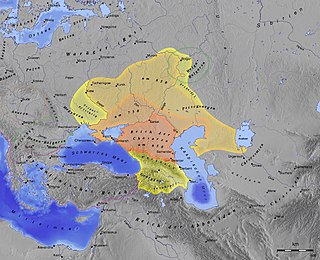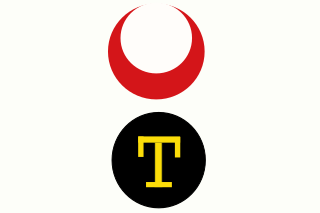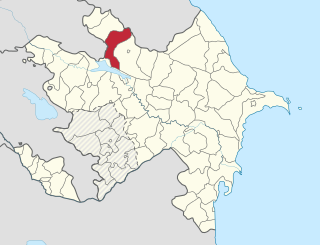
The Khazars were a semi-nomadic Turkic people with a confederation of Turkic-speaking tribes that in the late 6th century CE established a major commercial empire covering the southeastern section of modern European Russia. The Khazars created what for its duration was the most powerful polity to emerge from the break-up of the Western Turkic Khaganate. Astride a major artery of commerce between Eastern Europe and Southwestern Asia, Khazaria became one of the foremost trading emporia of the medieval world, commanding the western marches of the Silk Road and playing a key commercial role as a crossroad between China, the Middle East and Kievan Rus'. For some three centuries the Khazars dominated the vast area extending from the Volga-Don steppes to the eastern Crimea and the northern Caucasus.

The Kipchaks were a Turkic nomadic people and confederation that existed in the Middle Ages, inhabiting parts of the Eurasian Steppe. First mentioned in the 8th century as part of the Turkic Khaganate, they most likely inhabited the Altai region from where they expanded over the following centuries, first as part of the Kimek Khanate and later as part of a confederation with the Cumans. There were groups of Kipchaks in the Pontic–Caspian steppe, Syr Darya and Siberia. The Cuman–Kipchak confederation was conquered by the Mongols in the early 13th century.

Crimean Tatar, also called Crimean Turkic or simply Crimean, is a Kipchak Turkic language spoken in Crimea and the Crimean Tatar diasporas of Uzbekistan, Turkey, Romania and Bulgaria, as well as small communities in the United States and Canada. It should not be confused with Tatar proper, spoken in Tatarstan and adjacent regions in Russia; the languages are related, but belong to two different subgroups of the Kipchak languages and thus are not mutually intelligible. Crimean Tatar arrived in the 13th century with the Mongol Golden Horde, succeeding the Crimean Greek and Crimean Gothic Principality of Theodoro, and continued through the 15th–18th century Crimean Khanate period. Though only distantly related, it has been extensively influenced by nearby Oghuz Turkic languages such as Azerbaijani, Turkish and Turkmen.

The Crimean Khanate was a Turkic state of the Ottoman Empire from 1441 to 1783, the longest-lived of the Turkic khanates that succeeded the empire of the Golden Horde of Mongol origin. Established by Hacı I Giray in 1441, the Crimean khans were the patrilineal descendants of Toqa Temür, thirteenth son of Jochi and grandson of Genghis Khan through marriage; Temür married one of Genghis Khan's granddaughters. Though, according to a well-know Russian historian, Doctor of Historical Sciences, professor of the Russian Academy of Sciences Zaitsev Ilya Vladimirovich, the Crimean Khanate was an independent state during all its history. The khanate was located in present-day Russia, Ukraine, Romania and Moldova.

Qasim Khanate or Kingdom of Qasim or Khanate of Qasım was a Tatar khanate, a vassal of Russia, which existed from 1452 until 1681 in the territory of modern Ryazan Oblast in Russia with its capital Kasimov, in the middle course of the Oka River. It was established in the lands which Grand Prince Vasily II of Moscow presented in 1452 to the Kazan prince Qasim khan, son of the first Kazan khan Olug Moxammat.

Qakh District, also Kakhi or sometimes Gakh, is a raion (district) in the north of Azerbaijan, on the border with Georgia (Kakheti).

Gypjak is a small village about 10 kilometers away from the Turkmen capital of Ashgabat.

The Gardarike Runestones are runestones in Scandinavia that mention voyages to the East (Austr) or the Eastern route (Austrvegr), or to more specific eastern locations such as Garðaríki.
The Chigil were a Turkic tribe known from the 7th century CE as living around Issyk Kul lake area. They were considered to be descended from two of the "Six Chuy tribes" of the Chuban, the Chuyue and Chumi. They are known to have been speakers of the Oghuz group of the Turkic languages.
Boniak, Bonyak or Maniac, also known as Boniak the Mangy, was "one of the most prominent Cuman chieftains" in the late 11th century and the early 12th century. He headed a powerful Cuman tribe or clan that inhabited the steppes to west of the Dnieper River. He supported the Byzantines against the Pechenegs in the Battle of Levounion in 1091. He defeated Coloman, King of Hungary in 1097 or 1099.
The founding of Moldavia began with the arrival of a Vlach (Romanian) voivode, Dragoș, soon followed by his people from Maramureș to the region of the Moldova River. Dragoș established a polity there as a vassal to the Kingdom of Hungary in the 1350s. The independence of the Principality of Moldavia was gained when Bogdan I, another Vlach voivode from Maramureș who had fallen out with the Hungarian king, crossed the Carpathians in 1359 and took control of Moldavia, wresting the region from Hungary. It remained a principality until 1859, when it united with Wallachia, initiating the development of the modern Romanian state.










